

Oratories and Confraternities
This page covers a number of oratories and ex-oratories in Perugia, some but not all of which belonged to lay confraternities. Giovanna Casagrande (referenced below) has listed the eleven such confraternities that existed in the city in the first half of the 14th century:
-
✴six were associated with the mendicant orders:
-
•Confraternita di Sant’ Agostino (Augustinian);
-
•Confraternita di San Domenico (Dominican);
-
•Confraternita di San Pietro Martire (Dominican, Walk IV below);
-
•Confraternita di San Francesco (Franciscan);
-
•Confraternita dell’ Annunziata (Servite); and
-
•Confraternita di San Simone (Carmelite); and
-
✴five were not:
-
•Confraternita di San Benedetto (Walk VI below);
-
•Confraternita di San Fiorenzo, which merged with the Confraternita di San Simone (above) in 1571;
-
•Confraternita di Sant’ Antonio Abate (Walk VI below);
-
•Confraternita di San Pietro Apostolo (Walk IV below); and
-
•Confraternita di San Pietro Abate (which is not included in this site).
Those in red obviously have their own pages in this website. Most of the others are described below.
Two oratories that were established at a later date also have their own pages in this website:
Walk III
Oratorio di Santa Cecilia (1687-90)
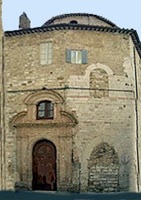
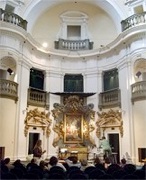
The Oratorian Fathers of San Filippo Neri built this oratory on land near their church that they acquired from Andrea Sciri. It was purpose-built for musical devotion, to a design by Pietro Baglioni, and dedicated it to St Cecilia, the patron saint of music.
The oratory was used extensively for musical performances throughout the 18th century, but subsequently fell into disuse. The building was used as a cinema in the mid-20th century, but has subsequently been restored. It is now used as an auditorium.
Madonna and Child with saints (1688)
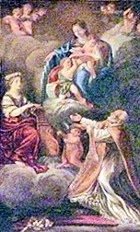
Oratorio dei SS Girolamo, Francesco e Bernardino (1450)
Blessed James of the Marches prompted the formation of the Confraternita dei Santi Girolamo, Francesco e Bernardino during a stay at San Francesco al Prato in 1445. The confraternity was given the perpetual use of an oratory in this convent in 1450.
Art from the Oratory
Madonna and Child with saints and angels (ca. 1450)
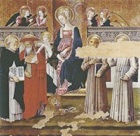
The panel depicts the Madonna and Child enthroned with SS Thomas Aquinas, Jerome (with his lion), Francis and Bernardino in front of a low parapet, behind which stand four praying angels. It is odd that the most prominent of these saints is the Dominican, St Thomas, to whom the baby Jesus passes a bright object that is an allegory of his teaching. Each of the saints holds a book, but that of St Thomas is open, revealing the words that Christ spoke to him as he prayed before a Crucifix: “Bene scriptisi de me Thoma ...” (You have written well of me Thomas ...).
Blessed James of the Marche (16th century)
This banner, which is attributed to Perugino, depicts the Blessed James of the Marche holding a reliquary of the Blood of Christ. It was noted in an inventory of the possessions of the confraternity in 1532, but not in an earlier one from 1517, suggesting that it was commissioned thereafter. The oratory was demolished in 1797, at which point the banner was moved to the church. It was moved to the Accademia di Belle Arte in 1810 is now in the Galleria Nazionale.
Walk IV
Oratorio di San Pietro Apostolo (1579)
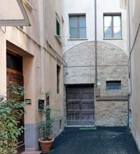
Oratorio di San Pietro Martire (14th century)
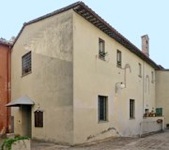
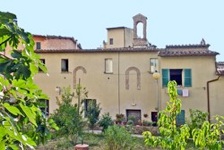
According to local tradition, the Dominican Rinalduccio Vincioli founded the flagellant Confraternita di San Pietro Martire in 1332 (see note 28 in the paper by Giovanna Casagrande referenced below). It was first recorded in this location in 1363. The confraternity was suppressed in 1797 but re-established in 1801, when it was merged with the Confraternita della Consolazione (below). It was suppressed again, this time definitively, in 1860. Today, the building is almost unrecognisable, except for the surviving campanile.
Dr Sheri Shaneyfelt (referenced below) has published a series of documents that relate to payments that the confraternity made in 1493 to Giannicola di Paolo for "certain figures" that he had painted for the oratory, but these have been lost. One of these documents records that the confraternity was then dedicated to the Corpus Christi (body of Christ) as well as to St Peter Martyr.
Walk V
Oratorio di Santa Maria della Consolazione (1500)
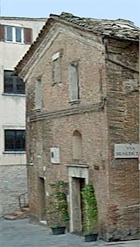
By 1822, when Serfino Sieppi wrote his guide to Perugia, the oratory near the remains of the Porta di San Cristoforo had deteriorated into a "miserable hovel". However, he could still discern the facade with its two doors, each of which led to a chapel with an altar on its back wall.
Gonfalon della Consolazione (ca. 1496-8)
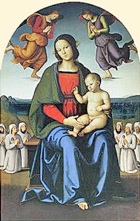
When the confraternity was suppressed in 1797, one of its members hid the banner in his home in order to avoid confiscation by the French. When the confraternity re-opened and merged with the Confraternita di San Pietro Martire in 1801, and the banner was moved to the Oratorio di San Pietro Martire (above). It entered the Galleria Nazionale in 1863.
The banner, which has been recently restored, depicts the Madonna and Child seated in a rural landscape and flanked by a pair of praying angels, with members of the confraternity kneeling to the sides.
Crucifixion (1522)
This fresco, which is dated by an inscription at the base of the cross, was detached from a wall in the abandoned oratory in 1819. It is now in the Galleria Nazionale.
The fresco was documented in 1791, with an attribution to Pompeo Cocchi. This attribution was sustained until comparatively recently. However, recent scholarship has attributed it to Mariano di Ser Austerio.
Walk VI
Oratorio di Sant’ Antonio Abate (14th century)
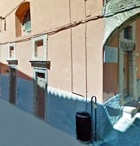
A female confraternity known as the Compagnia della Sorelle Spedaliere, which was documented as looking after the hospice in the 15th century, was suppressed in 1697 at the request of the Olivetans of the nearby church of Sant’ Antonio Abate.
The oratory took on its present form in the 16th century and was restored in 1735. The goods of its hospice were transferred to the Ospedale di Santa Maria Misericordia in 1737.
It will be possible [I think] to visit the oratory will take place on the Festa di Sant’Antonio Abate on 17th January 2016 - see website of the local association.
Gonfalon of St Antony Abbot (1512)
This processional banner, which is signed by Sinibaldo Ibi and dated by inscription on the reverse, depicts St Antony Abbot enthroned with two members of the the Confraternita di Sant’ Antonio Abate. It was first documented in 1907, when the confraternity gave it to the Galleria Nazionale. Although there is no earlier record of it, it almost certainly came from the oratory, and was probably used in the annual procession during the blessing of animals carried out each year on the feast of St Antony Abbot (17th January). [The banner was removed from the deposit of the gallery in January 2011 and returned to its original location in the Oratorio di Sant’ Antonio Abate.]
Frescoes (18th century)
The frescoes on the walls and ceiling comprise figures by Francesco Appiani set in [decorative frames ??] by Nicolò Giuli. Those on the walls are very badly damaged, but those on the ceiling are relatively well preserved.
Oratorio di San Benedetto (1598)
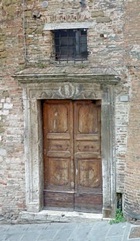
Valentino Martelli designed the present oratory, which now houses a branch of Centro Turistico Studentesco (CTS).
Copy of the Madonna degli Alberelli (19th century)
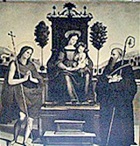
The altarpiece was transferred from its original wooden frame to the present stucco frame when the oratory was remodelled in 1598. It was transferred to the Galleria Nazionale and replaced by the present copy in 1863.
Scenes from the Lives of SS John the Baptist and Benedict (ca. 1610)
These frescoes by Matteuccio Salvucci are in the vault. Local historians record that this work was so well received that Salvucci was made an honorary member of the Confraternita di San Benedetto.
Art from the Oratory
Madonna degli Alberelli (1508-9)
This altarpiece was first recorded in 1509, when it was the subject of a dispute between the Confraternita di San Benedetto and Eusebio da San Giorgio that resulted in an additional payment to the artist. He also had another dispute at this time with Giovanni Battista Bastoni, which related to the late delivery of a wooden frame, probably for the same commission.
The altarpiece, which depicts the Madonna and Child enthroned with SS John the Baptist and Benedict, takes its names from the trees that flank the throne. It seems to have been removed from its original frame in the 16th century and placed in the stucco frame that survives in the ex-oratory. The altarpiece was moved to the Galleria Nazionale in 1863 (and replaced by a black and white copy that survives in situ). It was restored in 1960.
Oratorio di San Giovanni Battista (1636)
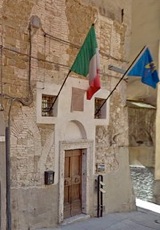
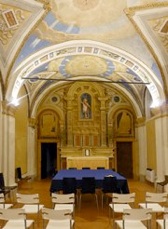
The Confraternita di San Giovanni Battista was formed in ca. 1570 to assist in the annual celebrations on the feast of St John the Baptist (24th June). Its statutes were approved by Bishop Francesco Bossi in 1577.
The confraternity initially had an altar in the church of Sant’ Antonio Abate. They bought houses here for the purpose of constructing an oratory from 1617, and finally completed the project in 1636. From this point, the consecrated Host was taken in procession each year on the feast of St John the Baptist from the oratory to Santa Maria Nuova and Sant’ Antonio Abate.
The inscription above the portal records the restoration of the oratory in 1705.
[Note that the oratory has recently re-opened and some of its original art works have been returned here. It features in the annual celebration ‘L’Estate di San Giovanni. Erbe e Fiori al Borgo’, which is held in June (on the summer solstice].
Birth of St John the Baptist (ca. 1640)
This panel, which was originally on the altar of the oratory, is by Giovanni Francesco Bassotti. In the background, St Elizabeth, the mother of the new baby, is attended by servants and watched over by her husband, Zacharias. In the foreground, a servant hands the new baby to the Virgin Mary while another servant prepares a bath.
When Bishop Orazio Monaldi visited the oratory in 1644, he was critical of the content of the “novita depicta” (new picture) and required it to be amended, but there is no sign that this was ever put into effect.
The painting was moved from the altar to the sacristy at some point and then, in 2003, to the Museo Capitolare. It is now (2013) temporarily in Palazzo Vescovile.
Walk VII
Oratorio dei SS Crispino e Crispiniano (1618-25)
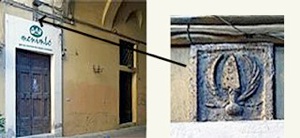
The oratory belonged to the Compagnia del Calzolari (cobblers’ guild), which was formed by five devout shoemakers in 1613. The brothers first used a chapel in Sant’ Ercolano and then moved to SS Severo e Agata before building an oratory of their own.
The façade is now unrecognisable, but the cobblers' coat of arms survives over the door of the shop to the right of the news stand.
Read more:
S. Shaneyfelt, “A Reappraisal of Giannicola di Paolo's Early Career”, Burlington Magazine, 149 (2007) 39-42
G. Casagrande, “Penitenti e Disciplinati a Perugia e loro Rapporti con gli Ordini Mendicanti”, Mélanges de l' Ecole Francaise de Rome", 89 (1977) 431-44
Return to Monuments of Perugia.
Return to Walk VII.

